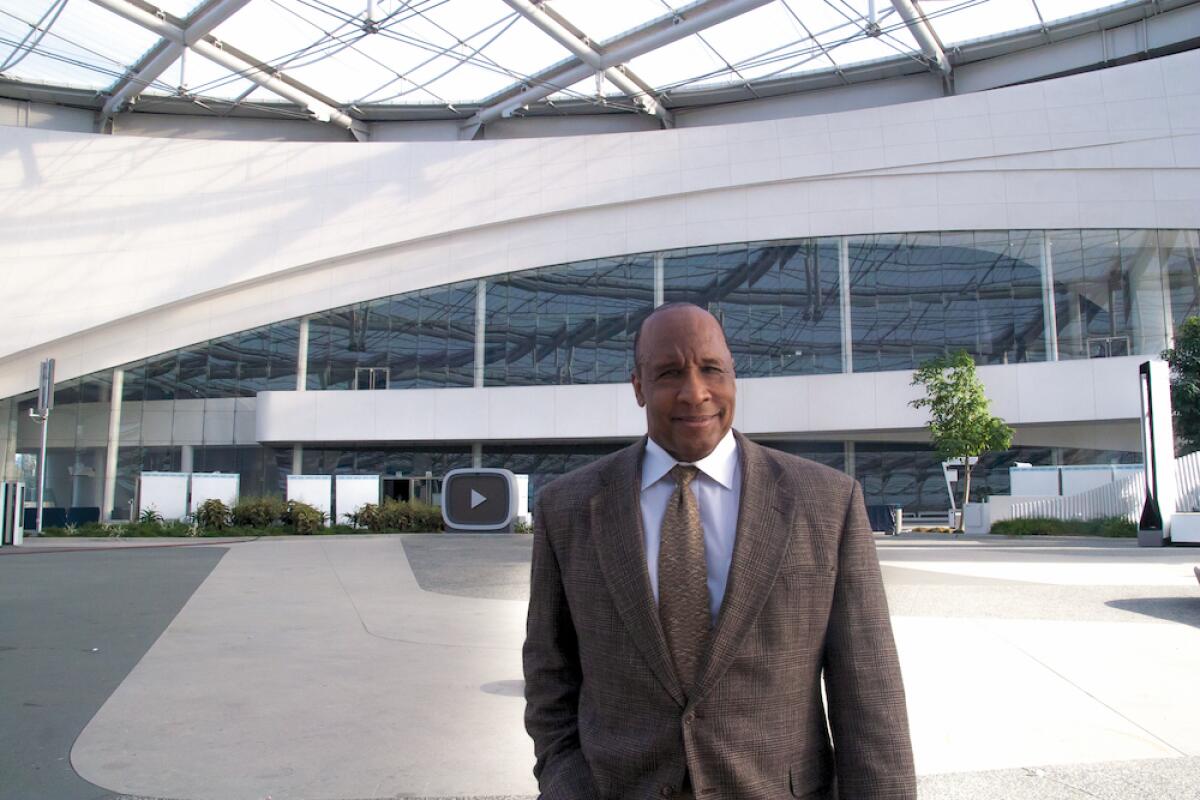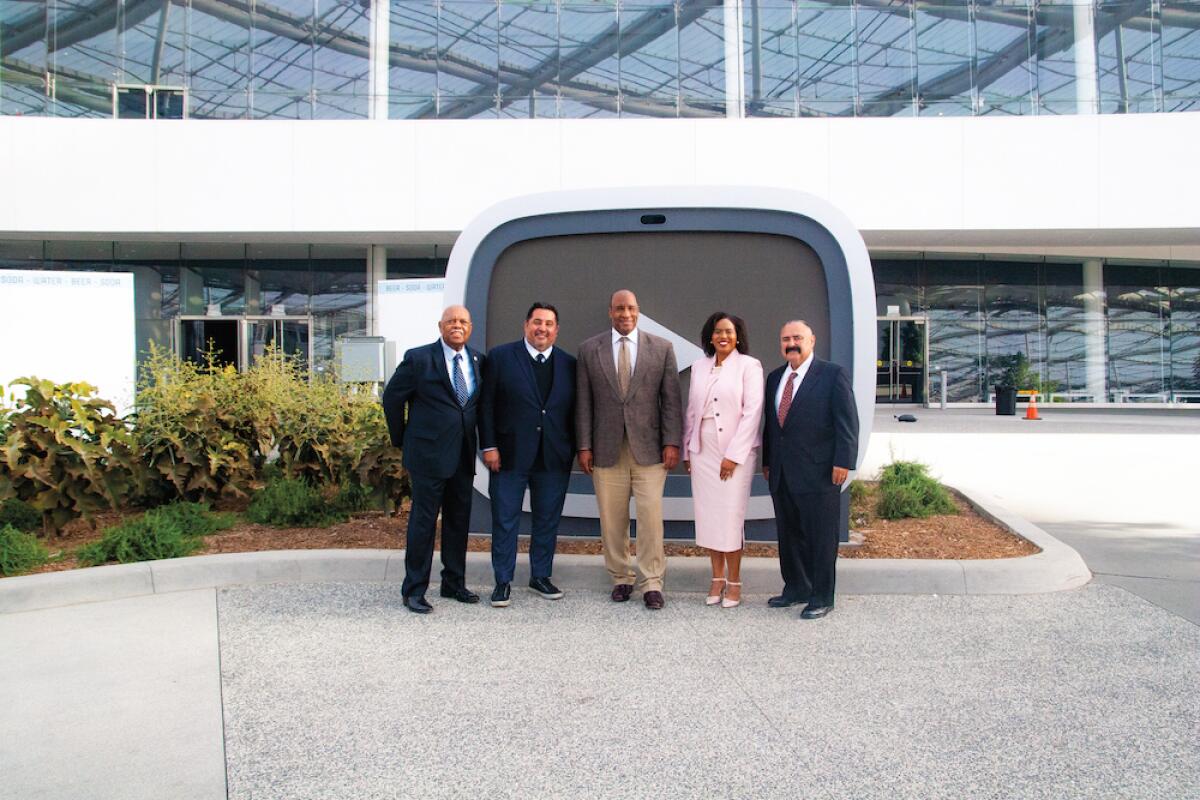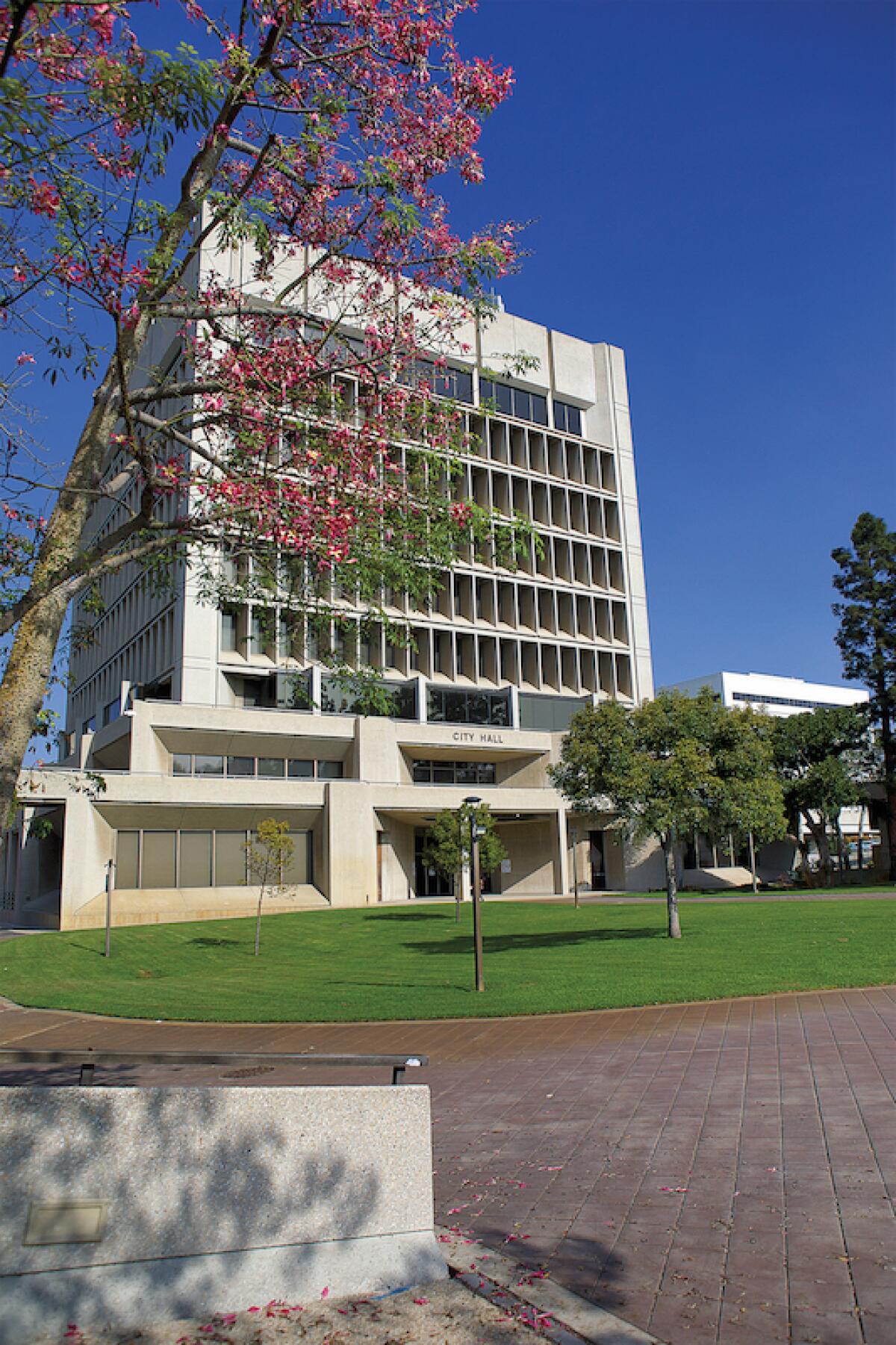A Man and a Plan: Inglewood’s Mayor Builds from His Past and Plans for the Future

Inglewood mayor James T. Butts Jr. doesn’t recall where he first heard the phrase “the only thing that has changed in Inglewood is everything.” But he likes it. He stands by it. And he’s been the single most significant figure behind it since assuming office in 2011.
Over that decade, Butts has spearheaded an uncommon renaissance for the South Bay city once dubiously (and often unfairly) famous for its crime and floundering economy. Embodying the dream of all those striving for equality, equity and inclusion, he has built a flourishing majority-minority city equal to any in the world - set to host both Super Bowl LVI and 2028 Olympic events - yet wholly inclusive and protective of its Black and Brown residents.
A chat with Mayor Butts is like interviewing an encyclopedia - a living encyclopedia of all things Inglewood. His passionate understanding of everything from the multibillion- dollar redevelopment deals that are reshaping the city of 110,000 to minutiae like its tree-trimming schedule is astonishing, as is his precise recall of related names, dates and data.
A Dynamic Force
A dynamic force in Los Angeles for decades, Butts broke through boundaries in a glittering law enforcement career in both Inglewood and Santa Monica. As a politician, he has been a voice for the voiceless while offering a bright future for his economically challenged city through business growth, improved infrastructure, and by revitalizing Inglewood as a major sports and entertainment epicenter.
Behind headline-grabbing glamor projects like revitalizing the storied Forum sports arena and attracting three professional sports teams (the NFL’s Rams, Chargers, and the NBA’s Clippers) to Inglewood, Butts has also enacted bold and progressive measures to slash debt and retain wealth for city residents. Since he took office, Inglewood’s bond rating improved from BBB- to AA-. Crime rates shrank to record lows. Pre-pandemic, Inglewood unemployment had plummeted from 17.5% to 4.7%, while property values had skyrocketed more than 200% since 2012.
In many Los Angeles neighborhoods, the specter of creeping affluence, creating displacement and loss of opportunities primarily for longstanding minority enclaves, looms heavily. Mayor Butts was keenly aware of this issue, and purposefully steered the city along another path. “Displacement is not what’s happening in Inglewood,” Butts insisted. “Inglewood’s done the opposite thing. Inglewood is still 93% Black and Brown.”
Through a series of inspired development agreements and economic initiatives, the mayor, who holds a master’s in Business Administration, has made Inglewood a much more desirable place to live and do business - desirable to the point of area real estate agents lately using “Inglewood-adjacent” as a selling point, something unthinkable even ten years ago. This allows longtime residents whose homes were previously losing value to now develop generational wealth, an enormous step towards creating equity. “That’s not gentrification,” said Butts. “That’s just people saying, ‘I think Inglewood’s safe; I think Inglewood’s a good investment; I think it’s a good place to live.’ And that is the dream of every city.”

Loyalty and Devotion
Growing up in L.A.’s Inglewood-adjacent Crenshaw district, Butts recalls being “a very focused child.” His early ambitions were to be either a corporate attorney or a Los Angeles Laker. He became neither but displays the thinking and determination of both.
“I loved basketball,” he recalled. “When other kids would sleep in, I’d get up at six, go up the hill to the Catholic church, hop the fence and practice my fundamental left-hand dribble or left-hand layups.” When injuries ended his basketball career at Cal State Los Angeles, Butts answered an ad for community service officers at Inglewood Police Department, starting at $3.57/hour. He was just the second Black cadet in the division. This was the start of a meteoric law enforcement career that included stints as a Metro undercover officer, homicide detective, and SWAT commander.
Between 1980 and 1990, Butts was promoted five times, eventually to Deputy Chief of Police - the first Black person to attain that level in the South Bay. This part of his life also influenced his decision when he was first approached to vie for Mayor of Inglewood some twenty years later.
“I did feel a great sense of loyalty and devotion to the city, because the city gave me my start,” he recalled. “I grew up in the 77th Division ... I didn’t have good experiences with the police. But the City of Inglewood hiring me and exposing me to this great, honorable service, I wanted to help if I could.”
But first came 15 years as Chief of Police in Santa Monica, during which crime was reduced by 64%. He was the first African American to hold that position, and the youngest and longest-tenured single-term Chief in the city’s history. When he left in 2006, crime in Santa Monica was at a half-century low.
“We changed use-of-force policies. The city was spending, on average, $3 million a year in liability claims for bad shootings, so we were the first department to prohibit shooting at moving vehicles,” Butts explained. “The year before I left, our total liability exposure was $1,849. And that’s unheard of.”
Butts’ stellar record continued in his three-plus years overseeing public safety and counterterrorism for Los Angeles World Airports, owners and operators of LAX and Van Nuys airports. By expanding the airport police department, improving training and discipline, and fostering better relationships with local law enforcement agencies, he helped significantly reduce crime and steered LAX to a No. 1 ranking nationwide by the TSA in 2009.

Return to Inglewood
When Inglewood’s mayor had to step down in 2010, Butts was approached by a group of stakeholders and asked to run for the office. At that point, “that was just not anything I ever considered doing,” he remembered. When he was officially elected on January 27, 2011, Butts inherited a near-bankrupt city operating at an $18-million deficit. Inglewood’s police department was going to be dissolved and a contract the sheriff’s department reinstated. The city was almost unrecognizable from his days as a young police officer.
“The Inglewood that I left in 1991 had the three-peat ‘Showtime’ Lakers, the Kings of hockey, the racetrack,” he recalled. “The racetrack was doing about 43,000 people on the average day, six days a week.”
But the Lakers and Kings had both left Inglewood’s legendary Forum arena in 1999 for the newly built Staples Center in Downtown L.A. And, after booming in the early ‘90s, the Hollywood Park Racetrack was on its last legs and would soon be demolished.
“Government will be smaller, leaner, and must, by necessity, increase overall efficiency,” Butts promised in his first State of the City address, which focused on public safety, fiscal solvency, and unified city leadership.
“Our institutions and actions will be more transparent and responsive to the desires of its residents.” He swiftly addressed Inglewood’s biggest budgeting problem, unfunded liabilities, by replacing its non-funded lifetime retiree medical program with an employee health savings plan. Long-overdue infrastructure renovation followed, with the city spending $1.18 million on sewer projects during Butts’ first year as mayor, compared to just $140,000 the prior year, while laying miles of underground optic fiber and upgrading roads.
“We changed just the topography of the city and the livability of the city,” said Butts. “In the last seven, eight years we have reconstructed or renewed more lane-miles of roadway, more linear feet of sidewalk ... than we had in the prior 40 years combined.” Creating a Master Plan
Butts almost immediately began negotiations with the Madison Square Garden Company to renovate the Forum, where he’d worked Lakers and Kings games as a cop during its 1980s heyday. As mayor, he sliced through bureaucratic red tape to move the project forward and by 2014 the storied arena was re-launched following a $100-million renovation.
The revived, 18,000-capacity Forum averaged a concert every week of its first year back in operation. Within 14 months, it was the No. 1 concert venue in California and second in the nation. It became both an economic boon in and of itself and a high-profile beacon that drew other major businesses to Inglewood.
Later that year, Butts was re-elected with 83% of the vote, the largest margin in Inglewood history. And, true to his commitment to the renewed infrastructure central to his Inglewood vision, he was also elected to the board of LA Metro, which he had patrolled as a police officer decades earlier.
But it was Butts’ next brilliant deal that cemented Inglewood’s rebirth as a global sports and entertainment city. When billionaire developer and St. Louis Rams owner Stan Kroenke visited City Hall in the summer of 2013 to discuss bringing his team to the old racetrack site, what was planned as a 15-minute chat turned into a two-and-a-half-hour negotiation that would transform the city.
“I said, this is the largest contiguous block of open land in urban Southern California,” Butts recounted. “It’s less than two miles from the second-busiest airport in the country, and it has a microclimate that is so wonderful that whenever it rains hard, we all have to buy new umbrellas because we don’t remember what we did with our umbrellas the last time it rained.”
What eventually emerged from that discussion was Hollywood Park: a $5-billion, 300-acre entertainment complex and master-planned neighborhood on the Hollywood Park Racetrack site and adjacent land. Its 70,000-seat SoFi Stadium centerpiece brought the NFL back to the L.A. area for the first time in two decades as home to both the Los Angeles Rams and the Los Angeles Chargers. It will host Super Bowl LVI and the opening and closing ceremonies of the 2028 Summer Olympics, as well as Olympic archery and soccer.
“To walk into for the first time ... was like walking inside of a living video game,” Butts marveled. “It was the most beautiful structure.”
Hollywood Park will also feature up to five million square feet of creative office space and 890,000 square feet of retail space, a 300-room hotel, and up to 2,500 sophisticated residences. The city-within-a-city also boasts the 6,000-seat YouTube Theater, a six-acre lake, and the NFL’s West Coast headquarters.
Tireless Transformation
Mayor Butts seldom rests. Within a month of that first stroll through SoFi Stadium, he was negotiating to bring the Los Angeles Clippers to a new arena on 28 acres of years-fallow Inglewood land. The resulting 18,000-seat Intuit Dome is scheduled to open in time for the 2024- 2025 NBA season.
Butts ensured that all of these developments will bring maximum benefits, but minimum risks, to the City of Inglewood and its residents. The Hollywood Park Project is almost entirely privately funded, and the $1.8-billion Intuit Dome wholly so. Local-hire goals guarantee jobs for Inglewood residents, with “hard-to-hire” provisions offering second chances for convicted felons. And the Clippers’ deal includes a $100-million community benefits plan comprising funding for affordable housing, assistance to renters and first-time home buyers, and school and youth programs.
“Inglewood has the lowest cap on rents of any city in the South Bay,” Butts continued. “We have more affordable housing, percentage-wise, we have the lowest average rents. So, we’ve been able to maintain the ability for people to get jobs, progress, and hold on to their living spaces.”
In 2015, Butts agreed to a public-private partnership to erect state-of-the-art digital billboards that would help fund further business-friendly infrastructure upgrades. These will include the $1-billion Inglewood Transit Connector, an automated people mover linking the city’s sports complexes to the regional Metro Rail system.
Butts’ Inglewood economic miracle has continued to snowball, despite the challenges of the coronavirus pandemic (when COVID-19 hit, he successfully lobbied to have the SoFi project declared essential and continue). Butts cut the ribbon on a new Girl Scouts of America regional headquarters in the city in 2019, and this past October the Los Angeles Philharmonic’s Youth Orchestra of Los Angeles opened its new Frank Gehry-designed home in Inglewood, with Inglewood students comprising 80% of its musicians.
“The single crowning achievement of my career today is to have the LA Philharmonic, which exists in only two of the 80 cities in L.A. County, open their Youth Orchestra program right here adjacent to City Hall,” said Butts.
Future Fruition
Mayor James T. Butts Jr. is far from done with repaying the city that gave him his big break as a young man. In 2018, he won a third term as Inglewood mayor by another huge margin and has no plans to slow down.
“My vision for the city is to see the Inglewood Transit Connector come to fruition and to see the impact of the $100-million community benefits package manifested for the residents of Inglewood,” he said. Butts adds, “And to see the full Hollywood Park development ... in its full glory and full bloom, so that residents of Inglewood never have to leave this nine-square-mile city to get anything - whether it be entertainment, retail, or dining - that they want.”